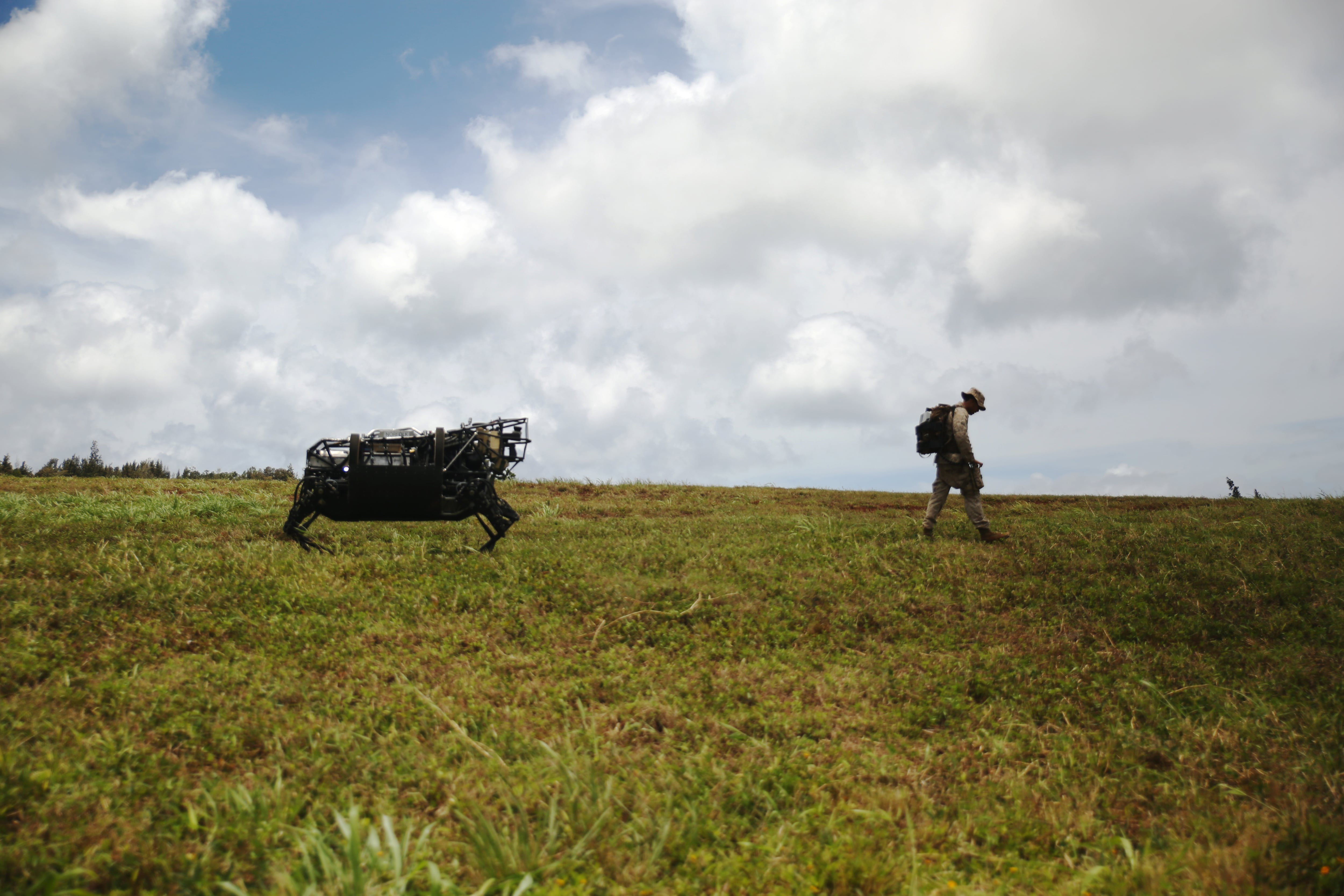The Marine Corps has dabbled in drones for a while: It has invested in quadcopters for infantry squads, robotic mules that lug gear, even, earlier in 2023, its first MQ-9 Reaper hunter-killer unmanned aerial vehicle.
Now, though, Marine leaders want to bring all of the service’s unmanned systems efforts under one roof in hopes of developing sustainable career pipelines and catching up to the sprint pace of technology development.
The service’s new catch-all term for the technology, “intelligent robotics and autonomous systems,” or IRAS, made its debut in June’s update to Force Design 2030. That document called on deputy commandants to build intelligent robotics and autonomous systems into the forcewide experimentation plan; streamline acquisition of the most rugged and highly demanded unmanned systems; and develop a strategy to “integrate robotics specialties throughout the total force,” among other taskers.
“Marines must fight at machine speed or face defeat at machine speed,” the design document stated, citing the pivotal role of drones in the 2020 Nagorno-Karabakh war in Azerbaijan, and more recently in Russia’s war of aggression in Ukraine.
RELATED

The man at the helm of this effort to integrate drone ops fully into Marine warfare is Maj. Keenan Chirhart, head of the service’s new four-person intelligent robotics and autonomous systems office. The former executive officer of the Marines’ first Reaper squadron, Chirhart must bring organization to the tangle of unmanned and autonomous development efforts in progress around the service.
As Marine Corps elements raced to integrate unmanned technology to its operations, from aviation to logistics, he said, stovepipes developed, thwarting effective communication and planning.
One possible initiative under consideration, Chirhart said, is a common mission controller capable of -operating all unmanned systems, from small aerial drones to ground vehicles and even surface vessels.t told Marine Corps Times. “You’ve got this multifunctional, multidomain capability. And there certainly needs to be oversight, so that it’s not just being developed within one war-fighting domain.”
One possible initiative under consideration, Chirhart said, is a common mission controller capable of operating all unmanned systems, from small aerial drones to ground vehicles and even surface vessels.
“A modular controller would enable not only your decision-makers, at a strategic level, to see across all domains, but also allow, at the tactical level, multidomain control of different systems,” he said. “Those technologies exist right now; our [Marine Corps] Warfighting Lab has been experimenting with them.”
In the nearer future, Chirhart’s office will develop an experimentation road map that makes unmanned systems integral to overall Marine Corps technology experimentation efforts. The Force Design guidance lays the groundwork for the development of a dedicated unmanned experimental unit that can simulate multidomain operations featuring a range of intelligent robotics and autonomous systems.
Chirhart said his office is researching several privately owned range spaces where these experiments could take place and networking with commercial startups, think tanks and academic institutions as it determines that’s possible.
Marine leaders also are aware they need a stable career pipeline for unmanned systems. As the office collaborates with the Navy, which is developing a to strengthen its unmanned workforce, Chirhart said a similar Marine Corps military occupational specialty may be developed.
While the service already has a small unmanned aerial systems operator job and a dedicated job specialty for MQ-9 Reaper pilots, it lacks a cross-domain specialty to deliver expertise on autonomy and robotic warfare at large.
Discussions of a new military occupational specialty are “nascent,” Chirhart said, but added that the Corps is closely watching the Navy’s efforts to tackle the same career path problem.
“We’re not trying to replace the warfighter,” Chirhart said. “But we know that in the future, the warfighter is going to be augmented by teams of robotics and autonomous systems that operate in all domains. We want to understand what is the expertise needed to make sure that person is trained and equipped to be able to provide those functions for the Marine Corps in the future.”
Perhaps the most significant obstacle for the Marine Corps as it seeks to master smart drones and autonomy is the infamously sluggish acquisition process, built to take years, not months. Chirhart noted that any acquisition projects started today likely wouldn’t get funded until fiscal 2026.
“That is not going to allow the Marine Corps to keep pace with our adversary,” he said.
How to achieve rapid acquisition at scale is a problem that goes far beyond intelligent robotics and autonomous systems or the Marine Corps, but Chirhart said he’s optimistic that effective communication between Corps directorates, plus the unifying and specific directions within the Force Design update, will help the service move with speed and purpose.
“I think it’s very easy for everyone to look at what industry is producing and say, ‘I want that thing, I want that bright, shiny object,’” he said. “But what is more important in my mind is that we have a road map that is capabilities-centric, not platform-centric. It’s not that I care necessarily about a specific, intelligent robotic autonomous system. I want to look at what is the long-term overarching capability that the Marine Corps needs to execute its missions.”
Hope Hodge Seck is an award-winning investigative and enterprise reporter covering the U.S. military and national defense. The former managing editor of Military.com, her work has also appeared in the Washington Post, Politico Magazine, USA Today and Popular Mechanics.





